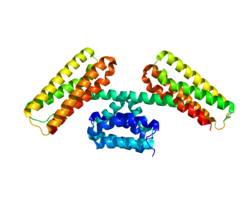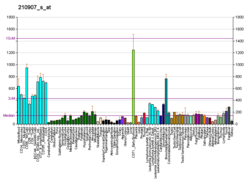PDCD10
Programmed cell death protein 10 is a protein that in humans is encoded by the PDCD10 gene.[5][6]
Function
[edit]This gene encodes a protein, originally identified in a premyeloid cell line, with similarity to proteins that participate in apoptosis. Three alternative transcripts encoding the same protein, differing only in their 5' UTRs, have been identified for this gene.[6]
Gene
[edit]Loss of function mutations in PDCD10 result in the onset of Cerebral Cavernous Malformations (CCM) illness.[5] Therefore, this gene is also called CCM3. Cerebral cavernous malformations (CCMs) are vascular malformations in the brain and spinal cord made of dilated capillary vessels.
Interactions
[edit]CCM3 encodes a protein called Programmed Cell Death 10 (PDCD10). The function of this protein has only recently begun to be understood. PDCD10 has roles in vascular development and VEGF signaling1,[7] apoptosis[8] and functions as part of a larger signaling complex that includes germinal center kinase III.[9][10] Specifically, PDCD10 has been shown to interact with RP6-213H19.1,[11] STK25,[11][12] STRN,[11] STRN3,[11] MOBKL3,[11] CTTNBP2NL,[11] STK24[11][12][13] and FAM40A.[11]
References
[edit]- ^ a b c GRCh38: Ensembl release 89: ENSG00000114209 – Ensembl, May 2017
- ^ a b c GRCm38: Ensembl release 89: ENSMUSG00000027835 – Ensembl, May 2017
- ^ "Human PubMed Reference:". National Center for Biotechnology Information, U.S. National Library of Medicine.
- ^ "Mouse PubMed Reference:". National Center for Biotechnology Information, U.S. National Library of Medicine.
- ^ a b Bergametti F, Denier C, Labauge P, Arnoult M, Boetto S, Clanet M, Coubes P, Echenne B, Ibrahim R, Irthum B, Jacquet G, Lonjon M, Moreau JJ, Neau JP, Parker F, Tremoulet M, Tournier-Lasserve E (Jan 2005). "Mutations within the programmed cell death 10 gene cause cerebral cavernous malformations". American Journal of Human Genetics. 76 (1): 42–51. doi:10.1086/426952. PMC 1196432. PMID 15543491.
- ^ a b "Entrez Gene: PDCD10 programmed cell death 10".
- ^ He Y, Zhang H, Yu L, Gunel M, Boggon TJ, Chen H, Min W (2010). "Stabilization of VEGFR2 signaling by cerebral cavernous malformation 3 is critical for vascular development". Science Signaling. 3 (116): ra26. doi:10.1126/scisignal.2000722. PMC 3052863. PMID 20371769.
- ^ Guclu B, Ozturk AK, Pricola KL, Bilguvar K, Shin D, O'Roak BJ, Gunel M (Nov 2005). "Mutations in apoptosis-related gene, PDCD10, cause cerebral cavernous malformation 3". Neurosurgery. 57 (5): 1008–13. doi:10.1227/01.NEU.0000180811.56157.E1. PMID 16284570. S2CID 10303325.
- ^ Fidalgo M, Fraile M, Pires A, Force T, Pombo C, Zalvide J (Apr 2010). "CCM3/PDCD10 stabilizes GCKIII proteins to promote Golgi assembly and cell orientation". Journal of Cell Science. 123 (Pt 8): 1274–84. doi:10.1242/jcs.061341. PMID 20332113. S2CID 6692474.
- ^ Ceccarelli DF, Laister RC, Mulligan VK, Kean MJ, Goudreault M, Scott IC, Derry WB, Chakrabartty A, Gingras AC, Sicheri F (Jul 2011). "CCM3/PDCD10 heterodimerizes with germinal center kinase III (GCKIII) proteins using a mechanism analogous to CCM3 homodimerization". The Journal of Biological Chemistry. 286 (28): 25056–64. doi:10.1074/jbc.M110.213777. PMC 3137079. PMID 21561863.
- ^ a b c d e f g h Goudreault M, D'Ambrosio LM, Kean MJ, Mullin MJ, Larsen BG, Sanchez A, Chaudhry S, Chen GI, Sicheri F, Nesvizhskii AI, Aebersold R, Raught B, Gingras AC (Jan 2009). "A PP2A phosphatase high density interaction network identifies a novel striatin-interacting phosphatase and kinase complex linked to the cerebral cavernous malformation 3 (CCM3) protein". Molecular & Cellular Proteomics. 8 (1): 157–71. doi:10.1074/mcp.M800266-MCP200. PMC 2621004. PMID 18782753.
- ^ a b Rual JF, Venkatesan K, Hao T, Hirozane-Kishikawa T, Dricot A, Li N, Berriz GF, Gibbons FD, Dreze M, Ayivi-Guedehoussou N, Klitgord N, Simon C, Boxem M, Milstein S, Rosenberg J, Goldberg DS, Zhang LV, Wong SL, Franklin G, Li S, Albala JS, Lim J, Fraughton C, Llamosas E, Cevik S, Bex C, Lamesch P, Sikorski RS, Vandenhaute J, Zoghbi HY, Smolyar A, Bosak S, Sequerra R, Doucette-Stamm L, Cusick ME, Hill DE, Roth FP, Vidal M (Oct 2005). "Towards a proteome-scale map of the human protein-protein interaction network". Nature. 437 (7062): 1173–8. Bibcode:2005Natur.437.1173R. doi:10.1038/nature04209. PMID 16189514. S2CID 4427026.
- ^ Ewing RM, Chu P, Elisma F, Li H, Taylor P, Climie S, McBroom-Cerajewski L, Robinson MD, O'Connor L, Li M, Taylor R, Dharsee M, Ho Y, Heilbut A, Moore L, Zhang S, Ornatsky O, Bukhman YV, Ethier M, Sheng Y, Vasilescu J, Abu-Farha M, Lambert JP, Duewel HS, Stewart II, Kuehl B, Hogue K, Colwill K, Gladwish K, Muskat B, Kinach R, Adams SL, Moran MF, Morin GB, Topaloglou T, Figeys D (2007). "Large-scale mapping of human protein-protein interactions by mass spectrometry". Molecular Systems Biology. 3 (1): 89. doi:10.1038/msb4100134. PMC 1847948. PMID 17353931.
Further reading
[edit]- Craig HD, Günel M, Cepeda O, Johnson EW, Ptacek L, Steinberg GK, Ogilvy CS, Berg MJ, Crawford SC, Scott RM, Steichen-Gersdorf E, Sabroe R, Kennedy CT, Mettler G, Beis MJ, Fryer A, Awad IA, Lifton RP (Nov 1998). "Multilocus linkage identifies two new loci for a mendelian form of stroke, cerebral cavernous malformation, at 7p15-13 and 3q25.2-27". Human Molecular Genetics. 7 (12): 1851–8. doi:10.1093/hmg/7.12.1851. PMID 9811928.
- Guclu B, Ozturk AK, Pricola KL, Seker A, Ozek M, Gunel M (Nov 2005). "Cerebral venous malformations have distinct genetic origin from cerebral cavernous malformations". Stroke: A Journal of Cerebral Circulation. 36 (11): 2479–80. doi:10.1161/01.STR.0000183616.99139.d3. hdl:11424/244289. PMID 16239636.
- Guclu B, Ozturk AK, Pricola KL, Bilguvar K, Shin D, O'Roak BJ, Gunel M (Nov 2005). "Mutations in apoptosis-related gene, PDCD10, cause cerebral cavernous malformation 3". Neurosurgery. 57 (5): 1008–13. doi:10.1227/01.NEU.0000180811.56157.E1. PMID 16284570. S2CID 10303325.
- Liquori CL, Berg MJ, Squitieri F, Ottenbacher M, Sorlie M, Leedom TP, Cannella M, Maglione V, Ptacek L, Johnson EW, Marchuk DA (Jan 2006). "Low frequency of PDCD10 mutations in a panel of CCM3 probands: potential for a fourth CCM locus". Human Mutation. 27 (1): 118. doi:10.1002/humu.9389. PMID 16329096. S2CID 30609244.
- Verlaan DJ, Roussel J, Laurent SB, Elger CE, Siegel AM, Rouleau GA (Dec 2005). "CCM3 mutations are uncommon in cerebral cavernous malformations". Neurology. 65 (12): 1982–3. doi:10.1212/01.wnl.0000188903.75144.49. PMID 16380626. S2CID 190798.
- Tsang HT, Connell JW, Brown SE, Thompson A, Reid E, Sanderson CM (Sep 2006). "A systematic analysis of human CHMP protein interactions: additional MIT domain-containing proteins bind to multiple components of the human ESCRT III complex". Genomics. 88 (3): 333–46. doi:10.1016/j.ygeno.2006.04.003. PMID 16730941.
- Labauge P, Krivosic V, Denier C, Tournier-Lasserve E, Gaudric A (Jun 2006). "Frequency of retinal cavernomas in 60 patients with familial cerebral cavernomas: a clinical and genetic study". Archives of Ophthalmology. 124 (6): 885–6. doi:10.1001/archopht.124.6.885. PMID 16769843.
- Chen PY, Chang WS, Chou RH, Lai YK, Lin SC, Chi CY, Wu CW (2007). "Two non-homologous brain diseases-related genes, SERPINI1 and PDCD10, are tightly linked by an asymmetric bidirectional promoter in an evolutionarily conserved manner". BMC Molecular Biology. 8: 2. doi:10.1186/1471-2199-8-2. PMC 1796892. PMID 17212813.
- Ewing RM, Chu P, Elisma F, Li H, Taylor P, Climie S, McBroom-Cerajewski L, Robinson MD, O'Connor L, Li M, Taylor R, Dharsee M, Ho Y, Heilbut A, Moore L, Zhang S, Ornatsky O, Bukhman YV, Ethier M, Sheng Y, Vasilescu J, Abu-Farha M, Lambert JP, Duewel HS, Stewart II, Kuehl B, Hogue K, Colwill K, Gladwish K, Muskat B, Kinach R, Adams SL, Moran MF, Morin GB, Topaloglou T, Figeys D (2007). "Large-scale mapping of human protein-protein interactions by mass spectrometry". Molecular Systems Biology. 3 (1): 89. doi:10.1038/msb4100134. PMC 1847948. PMID 17353931.
- Ma X, Zhao H, Shan J, Long F, Chen Y, Chen Y, Zhang Y, Han X, Ma D (Jun 2007). "PDCD10 interacts with Ste20-related kinase MST4 to promote cell growth and transformation via modulation of the ERK pathway". Molecular Biology of the Cell. 18 (6): 1965–78. doi:10.1091/mbc.E06-07-0608. PMC 1877091. PMID 17360971.
External links
[edit]- www.angioma.org Angioma Alliance
- www.ccm3.org CCM3 Action Archived 2021-11-09 at the Wayback Machine






